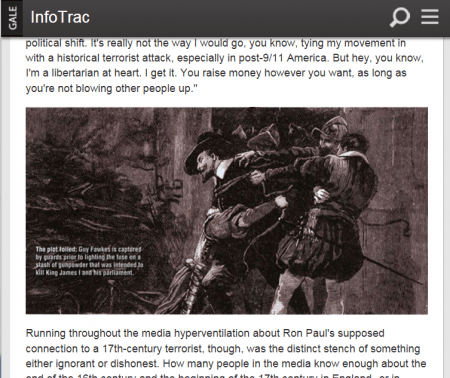Guy Fawkes has become something of an icon in the British psyche; we foster an underlying admiration for the plotter, despite his attempt to orchestrate murder. This is partly based on an innocent relish for royal intrigue and romanticised view of a time of ruffs, candles and pointed shoes. Yet there is a tension between British attitudes towards recent acts of social disorder, terrorism and violent political expression, and our euphemized view of attempted murder in seventeenth-century England. The complexity of our collective memorialisation and current attitude towards the Gunpowder Plot can be explored by charting its development in the Gale archives.

The reaction of society in the immediate aftermath of the plot was stringently managed by the government. As news spread, people were encouraged to light bonfires to celebrate that the plot was foiled and the king was safe, and an Act of Parliament was passed making this an annual memorial event. Describing the plotters as ‘malignant and devilish papists’ and their plot as ‘inhuman, barbarous and cruel’, the Act ensured Fawkes was framed as a criminal and viewed with scorn by seventeenth-century society. It is suggested, however, that James I was impressed by Guy Fawkes’ commitment to his faith and accomplices, even under torture, indicating a glimmer of admiration for Fawkes at the time, and from the very man targeted by the plot.
Also, a letter in the Gale resource State Papers Online by Sir William Waad, who conducted some of Guy Fawkes’ interrogations, shows it was recognised that Fawkes ‘had made a vow and were tied by oath’[1]. Yet in January 1606 he was publicly mutilated to confirm to society the severity of his crime. What’s more, the plot was used as an opportunity to conduct a vigorous crack down on English Catholics, and thus November 5th was associated with religious turmoil for much of the seventeenth century.
The cultural shifts that took place during the Enlightenment, however, impacted social attitudes towards 5th November traditions. Increasing religious tolerance removed the political bitterness that previously surrounded the Gunpowder Plot, allowing Bonfire Night to manifest into a new, apolitical form by the nineteenth century, centred largely on socialising and gorging on seasonal foods[2]. Articles such as ‘“Guy Fawkes” Night in Exeter’, in the Plymouth and Cornish Advertiser in 1876, found in the Gale resource 19th Century British Newspapers suggest it had become akin to a carnival (see highlighted extracts in document below) . Newspapers also provide evidence of this shift when documenting the disorder born of excessive revelling, from ‘rockets thrown amongst crowds’ (Exeter and Plymouth Gazette, 1876, 19th Century British Newspapers), to firemen battling firework-induced blazes (The Morning Chronicle, 1861, 19th Century British Newspapers), to fatal confrontations (Trewman’s Exeter Flying Post or Plymouth and Cornish Advertiser, 1883, 19th Century British Newspapers).
 In revolving largely around entertainment, Victorian Bonfire Nights were far closer to our modern day celebrations – if sometimes a little more extravagant! A vague awareness of the political roots of the event remains today, just as it did in the nineteenth century, but the night is far from saturated by religious machinations. Instead, chestnuts are roasted, apples dipped in toffee, and excited faces glow as the sky lights up with coloured light. A reduction in religious antagonism has also allowed the previously faint admiration for the nerve of the plotters to strengthen, making Guy Fawkes the icon he is today.
In revolving largely around entertainment, Victorian Bonfire Nights were far closer to our modern day celebrations – if sometimes a little more extravagant! A vague awareness of the political roots of the event remains today, just as it did in the nineteenth century, but the night is far from saturated by religious machinations. Instead, chestnuts are roasted, apples dipped in toffee, and excited faces glow as the sky lights up with coloured light. A reduction in religious antagonism has also allowed the previously faint admiration for the nerve of the plotters to strengthen, making Guy Fawkes the icon he is today.
Yet numerous Gale resources reveal a further reincarnation of the figure of Guy Fawkes which, diverging from the chestnut-eating of November 5th, is once again politicised. An article by Alex Conacher in Gale’s Business Collection explains the phenomenon.
‘In the days following the recent financial crash, and a growing recognition of the excesses of the political and financial sectors, there has been a burgeoning, sometimes hysterical, backlash against the establishment. At least for the last decade, many people have been remembering the Fifth of November in an entirely different light.’[3]
‘Today,’ says Scott Horton, referenced by The New American in General OneFile, ‘Guy Fawkes is increasingly viewed as…prepared to stand against an unjust and oppressive state, as a martyr and a victim of torture’. In some cases, the figure has even become an antihero, meeting oppression with violence; in the film V for Vendetta, a man wronged by the government wears a grinning Guy Fawkes mask as he orchestrates his revenge.
Furthermore, this mask has been taken up by real anti-government campaigners, both within the UK and abroad, becoming a label of the protest group ‘Anonymous’ and ‘Occupy Wall Street’ protests, and now symbolises organised grassroots rebellion – as discussed in the article ‘Quinn Norton charts how the pranksters from Anonymous became fully fledged, political activists’[5], found in Global issues in Context. This Gale resource also contains a video resource documenting Anonymous protests in London[6], whilst an interview with an anti-government journalist using the name ‘Guido Fawkes’ as a pseudonym for his reporting is available in The Independent Digital Archive[7].


Charting the development of cultural attitudes towards the Gunpowder Plot through the Gale archives has revealed it to be a fascinating and colourful phenomenon. With current debates over corruption, oppression and free speech continuing, often paired with instances of violent political expression, terrorism or other forms of social unrest, perceptions of the Gunpowder Plot are set to become increasingly complex and multifarious, adding another powerful layer to its already dramatic past.
[1] ‘Sir William Waad to the Earl of Salisbury’, Calendar of the manuscripts of the most Hon. the Marquis of Salisbury. Vol. 17: 1605. Reign: James I Date: Nov. 7 1605 Author: Sir William Waad Recipient: Earl of Salisbury Copyright: Crown copyright, STATE PAPERS ONLINE
[2] See, for example: Sharpe 198, in Michael D. Friedman “Shakespeare and the Catholic rebenger: V for Vendetta.” Literature-Film Quarterly 38.2 (2010): 117+. GENERAL ONEFILE
[3] Alex Conacher, “Remember the fifth of November.” Tunnels & Tunnelling International Nov. 2014: 3. BUSINESS COLLECTION
[4] Scott Horton in: Dennis Behreandt, “The real Guy Fawkes: the media have branded Guy Fawkes a terrorist, but the real story of the ‘Gunpowder Treason’ plot to destroy the British Parliament is not so clear-cut as some would have it.” The New American 24 Dec. 2007: 33+, GENERAL ONEFILE
[5] Quinn Norton, “Don’t worry, we’re from the internet: Quinn Norton charts how the pranksters from Anonymous became fully fledged, political activists.” New Internationalist Dec. 2012: 18+, GLOBAL ISSUES IN CONTEXT
[6] RAW VIDEO: Anonymous “Hacktivists” Rally Outside UK Houses of Parliament, Source: Russia Today, Copyright: Copyright 2012 NewsLook, Inc., GLOBAL ISSUES IN CONTEXT
[7] Sophie Morris, “Guido Fawkes.” Media weekly Independent (London, England) 5 Nov. 2007: 16, THE INDEPENDENT DIGITAL ARCHIVE


